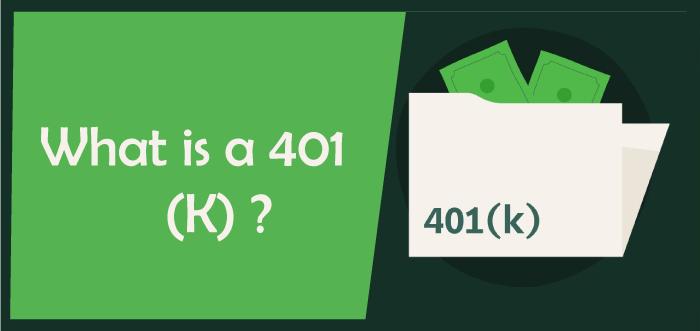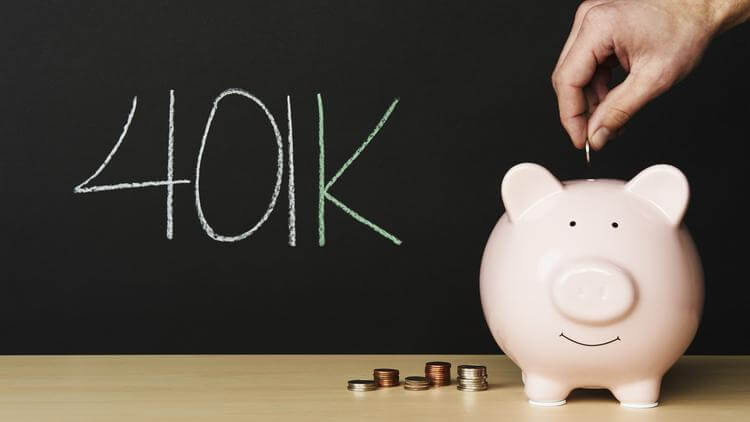What Is A 401(k) And How Does A 401(k) Work?There are a number of American firms that provide 401(k) plan to their customers, which exactly are plans for savings for retirement with a tax treatment that is pocket friendly for the customer. It has a section number from the Internal Revenue Code (IRC) of the United States. 
When a person decides to enroll in a 401(k) plan, the company asks for consent so that they can have a portion of each paycheck that is being put directly into the investing account. It is also possible for the employer to match all or a portion of the Contribution. Employees have a number of alternatives for investing, such as mutual funds, which are most commonly used. Important Points
401(k) Plan OperationIn order to encourage people so that they save for retirement, the US Congress decided to create the 401(k) plan. Tax savings are among the many advantages that are provided by them. There are two basic choices in a 401(k) plan, and each has its own unique tax benefits. Conventional 401(k)The money comes directly from the employee's wages and is liberated from taxes like a typical 401(k) because employee contributions are deducted from gross income. The employee's taxable income is thus reduced by the total contribution amount for the year, which can subsequently be claimed as a tax deduction for that particular tax year. Taxes are not required until the employee withdraws the money, which often happens in retirement, on either the contributed funds or the investment earnings. Roth 401(k)Contributions to a Roth 401(k) are deducted from the employee's after-tax revenue, which is their salary, less any income taxes deducted. Therefore, there is no tax break in the year of the donation. There are no further taxes that are owed when the money is withdrawn at the time of retirement or either the investment earnings or employee contributions. 
But a user should always keep in mind that every company doesn't provide the choice of a Roth account. The employee can choose either the standard 401(k) or the Roth if it is available, or both. They may donate to both up to the allowable annual cap. Making a 401(k) Plan contributionBoth the user and the employer are allowed to contribute to the fund up to the amount specified by the Department of Internal Revenue Services (IRS). Alternatives to the standard pension include established contribution plans and defined-benefit plans. With a pension, the company consents to pay the employee a predetermined amount each year while they are retired. 
Traditional pensions have grown less frequent over the past few decades as a result of businesses shifting the burden and risk of retirement savings to their employees through the use of 401(k) plans. In addition to that, from the list that is provided to the users by their respective companies, they are responsible for selecting the exact assets inside their 401(k) plans. Many times, those options contain a number of mutual funds for bonds, stocks, and target-date funds, which are formed so that the risk of investment losses can be reduced as the user gets closer to their retirement. They might also consist of those shares that are owned by the employer and GICs (guaranteed investment contracts) that are provided by the insurance companies. Contributions LimitsThe most that an individual or business may contribute to a 401(k) plan is raised every so often to account for inflation, a metric of rising prices in an economy. A $20,500 yearly cap on employee contributions is in place for workers under the age of 50. But individuals over 50 are qualified for a $6,500 catch-up contribution. Employee contributions are capped at $22,500 per year for individuals under 50 in 2023. Additionally, anyone 50 and older is eligible to make a $7,500 catch-up payment. Without taking into consideration the employer's additional contributions or the employee's choice to create additional, non-deductible after-tax contributions to their normal 401(k) account, the total Contribution for the year for both the employee and employer is as follows: 2022The combined payments for employee-employer are not supposed to be more than $61,000 in a year for those users who are under the age of 50 years. The cap is $67,500 when the catch-up payment for people over 50 is taken into consideration. 2023The combined payments for employee-employer are not supposed to be more than $66,000 annually for users under the age of 50. The cap is $73,500 when we focus on the catch-up payment for individuals who are of 50 years of age and older. Workplace MatchingEmployers who match employee contributions compute the match using a variety of formulae. For instance, an employer might match, up to a predetermined proportion of pay, 50 cents of every dollar that an employee contributes. Financial advisors frequently recommend to their clients that they contribute the absolute minimal amount necessary for their 401(k) plans to qualify for the full corporate match. Investing in Both Traditional and Roth 401(k) Plans If a company offers both normal and Roth 401(k) plans, an employee may contribute to both at different times. However, their cumulative deposits to the two types of accounts are limited to the maximum amount permitted for one account. Both standard and Roth 401(k) accounts are eligible for employer contributions. Both contributions and their gains are taxable at the time of withdrawal. How is a 401(k) Fund Earned?A person's company will invest their 401(k) contributions in accordance with the selections they make from the options that the company is providing. These choices sometimes include a wide range of mutual funds that invest in bonds and stock as well as target-date funds, which are composed so that the danger of investment losses can be reduced as one goes closer to retirement, as was previously mentioned. A user's annual contributions, whether their employer matches them or not, their investments, and the returns of their employers, in addition to the number of years until retirement, all of these things have an important impact on how quickly and how much one's money will grow. If a user decides to keep money in their account, they wouldn't need to pay any kind of taxes on investment gains, dividends, or interests until they take money out after retirement. Furthermore, if you establish a 401(k) when you're young, the power of compounding might enable it to generate more money for you. With compounding, savings returns can be returned to the account to begin generating their own returns. When a person leaves their job: At the time when a person leaves the company they have been working at and have a 401(k) plan going on, they are generally provided with four options. They are as follows:-
Although the withdrawal of the money isn't usually considered the best idea unless the client is in utter need of cash. The withdrawn money would be taxable in the year that it is withdrawn by the client. The user would get hit with the additional early distribution tax unless the user's age is 59 and a half and above, is permanently disabled, or falls in the several other IRS criteria that bring forth exceptions to the rule. When we talk about a Roth 401(k), as long as one has owned the account for the minimum duration of five years, they are free to withdraw their contributions (but not any earnings) at any time without paying any taxes or penalties. However, one should keep in mind that they are still reducing their retirement funds, which might be something they'd regret later.
By putting the cash into an IRA at a brokerage firm, mutual fund company, or bank, a user can easily avoid paying upfront taxes and keep the tax-benefited status of their account. Furthermore, one will have more investment options at their disposal than they would under the plan offered by their company. The IRS enforces rollover restrictions very strictly, and it can be costly to violate them. The financial institution that is scheduled to receive the funds will typically be more than eager to assist with the procedure and avoid any errors. In order to avoid tax penalties because of the plan, 401(k) withdrawals must be transferred to anyone else's retirement account within the span of 60 days.
Even when they are no longer able to contribute to it, employers frequently permit departing employees to keep their prior plan's 401(k) account for the rest of their lives. Typically, this applies to those accounts that have a $5,000 minimum balance. In the case of smaller accounts, the employer can insist that the worker move the money. If the 401(k) plan of their former company is very well-managed and they are pleased with the investment options it provides, it may make sense to keep their money in that account. Those employees who tend to move their jobs throughout their careers are more likely to leave a trail of old 401(k) plans behind them and often forget about some of them.
Generally, a person can easily transfer their 401(k) balance to the plan of their new job. This maintains the account's tax-deferred status and averts a user from paying taxes right away, much like with an IRA rollover. If a user doesn't feel positive about managing a rollover IRA's investments and is thinking about delegating part of the work to the new plan's administrator, it might be a wise decision from their side. Frequently Asked QuestionsHow Can a 401(k) Be Started?A 401(k) plan can be started with one's employer in the simplest possible method. There are a number of employers that provide 401(k) plans, and some of those plans are even similar to a portion of employees' contributions. Our 401(k) paperwork and payments in a situation like this will be taken care of by the business during onboarding. A person can be qualified for a solo 401(k), also famous by the term independent 401(k) plan, if they work for themselves or own a small business with their spouse. Is it a Wise Decision to Withdraw Money Early from Our 401(k)?An early withdrawal from their 401(k) is not really beneficial for the owner of the account. The owner will be subject to a 10% penalty in addition to any taxes they owe if they make withdrawals before the age of 59 years and a half. Despite this, there are some employers who give permission for withdrawal due to financial hardship caused due to unforeseen circumstances such as funeral expenses, medical bills, and other matters that require money immediately. Although one would still be subject to taxes on the withdrawal, this could be used to assist the users in avoiding the early withdrawal penalty. What is the Main Benefit of a 401(k)? A 401(k) can help a person lower their tax liability when they are investing for retirement. A person receives tax-deferred earnings in addition to hassle-free participation because contributions are automatically deducted from their salary. Apart from that, a number of firms will match a portion of their employees' 401(k) contributions, which would, in turn, increase their retirement savings without letting the individual bear any cost. ConclusionA 401(k) plan is a company retirement program that enables a user to contribute annually up to a predetermined level and invest that money for their future financial security when their working years are over. There are two types of 401(k) plans: Regular and Roth. Pre-tax contributions are made to a standard 401(k) in order to receive a tax advantage at the time of Contribution and lower their taxable income. On a user's withdrawals, however, they must pay regular income tax. The Roth 401(k) requires after-tax contributions and no tax benefit up front, but they won't pay taxes on their retirement withdrawals. Employer contributions are permitted for both accounts, which can improve their savings.
Next TopicAbenomics
|
 For Videos Join Our Youtube Channel: Join Now
For Videos Join Our Youtube Channel: Join Now
Feedback
- Send your Feedback to [email protected]
Help Others, Please Share










